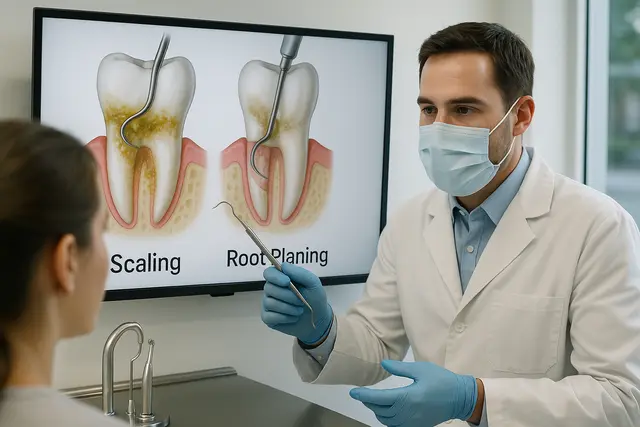General Dentistry
3 min read
Jun 06, 2025
Dental Xray Release Form: What It Is & How to Use It Properly
If you’re moving to a new dentist or seeing a specialist, chances are you’ll need your dental records to tag along, including your X-rays. That’s where a dental Xray release form saves the day. It’s a simple way to make sure your new provider gets the full picture of your dental health without unnecessary repeat scans or paperwork headaches.

Most of us don’t spend much time thinking about dental paperwork until we need to. But when you’re moving to a new dentist or seeing a specialist, one little piece of paper becomes incredibly useful: the dental Xray release form.
It may not be glamorous, but this simple form helps make sure your dental record can follow you where it’s needed, sparing you from repeat X-rays and giving your new provider a clearer picture of your oral health.
Here’s what it does, why it matters, and how to handle it without unnecessary hassle.
Your Dental Record: Why It’s More Than a Stack of Xrays
Your dental record tells the story of your mouth. It includes X-rays, sure, but also cleanings, treatment notes, procedures, and that little scribble your dentist made when you mentioned grinding your teeth at night. It helps paint a complete picture for any dentist who takes over your care.
Now, here’s the important part: dental records aren’t public documents. They’re protected. So if you want your dental history shared with another provider, you need to formally give permission. Enter: the release form. Oral health impacts more than you think, learn more about the link between oral health and overall wellbeing.
What the Release Form Does (And Why You Should Care)
A dental Xray release form gives written permission for a dental office to send your X-rays or entire dental record to another dentist or to you personally. Think of it as your official “yes, it’s fine to share this” document.
This matters because:
You’ll avoid unnecessary duplicate X-rays (which means less radiation and lower costs).
Your new dentist will see exactly what treatments you’ve already had.
Specialists can review your history before planning next steps.
It protects your privacy, nobody can access your record without your OK.
Without this release, most offices won’t send out your records at all, and for good reason. It’s about keeping your information safe.
Dental Xray Release Form Template

How to Use a Dental Xray Release Form the Right Way
This part is easier than people think. Most dental offices have a release form ready to go. All you need to do is ask. Here’s how it typically works:
First, request the form from your current dental office, either in person, by phone, or on their website if they offer one online.
Next, fill it out carefully. You’ll usually need to include:
Your name and contact info
The name of the dentist or office receiving your records
Which records you want released (you can request just X-rays or your full dental record)
Your signature and today’s date
Lastly, submit the form back to the office. Many will let you email it, though some may still prefer fax or good old-fashioned paper.
Once submitted, most offices process the request within a few days. If you need the records urgently (say, for an upcoming appointment), don’t hesitate to give them a polite nudge.
One Less Thing to Worry About
While it might seem like a small detail, handling your dental Xray release form properly can save you time, money, and even a bit of discomfort down the road. The form gives you control over your dental record and helps ensure seamless care, no matter where your dental journey takes you.
And when your new dentist has the full story in front of them, you’ll both be smiling.
What Is a Dental Xray Release Form and Why Is It Important?
A dental Xray release form is a document that gives written permission for your current dental office to send your X-rays or full dental record to another provider or to you. It’s essential for protecting your privacy and ensures your new dentist has access to your dental history without repeating unnecessary procedures or exposing you to additional radiation.
What Information Should I Include on a Dental Xray Release Form?
You should include your full name and contact information, the name of the dental office or provider receiving the records, a clear description of what you want released (just X-rays or the full dental record), and your signature with the date. Some forms may also ask for the reason for release and method of delivery.
How Do I Request and Submit a Dental Xray Release Form?
Start by contacting your current dental office to request the form—they may offer it in person, by email, or on their website. Fill out the required details, then return the form via email, fax, or in person, depending on the office’s preference. Most offices process requests within a few business days.
Can I Use a Dental Xray Release Form to Get My Own Records?
Yes, absolutely. Patients have the right to request copies of their own dental records, including X-rays. By submitting a completed release form, you can receive your records for personal use, future dental visits, or to share with another healthcare provider. It’s a simple way to stay informed and in control of your oral health.
Read Next
Related Posts

General Dentistry
How to Stop Nerve Pain in Tooth: Fast Relief That Works
Tooth nerve pain can be one of the most intense and disruptive types of discomfort. It often strikes without warning and makes everyday activities like eating, drinking, or even talking feel unbearable. Understanding what causes this pain and how to manage it effectively is key to getting fast relief.
4 min read
Sep 15, 2025

General Dentistry
Can a Sinus Infection Make Your Jaw Hurt? Understanding the Connection
Jaw pain can be unsettling, especially when it seems to appear out of nowhere alongside a stuffy nose or headache. Many people are surprised to learn that sinus infections can cause discomfort that feels like it’s coming from the jaw. Understanding the connection between your sinuses and jaw pain is key to getting the right treatment.
5 min read
Sep 15, 2025

General Dentistry
What Is SRP in Dentistry? A Complete Guide to Scaling and Root Planing
When it comes to dental health, most people think regular cleanings are enough to keep their smile safe. But sometimes, what’s happening below the gumline needs more attention. Scaling and root planing (SRP) is a treatment designed to address gum disease at its source, protecting both your gums and teeth from long-term damage.
5 min read
Sep 10, 2025
Don’t have time to research every dentist around you?
See why 30k+ patients trusted us